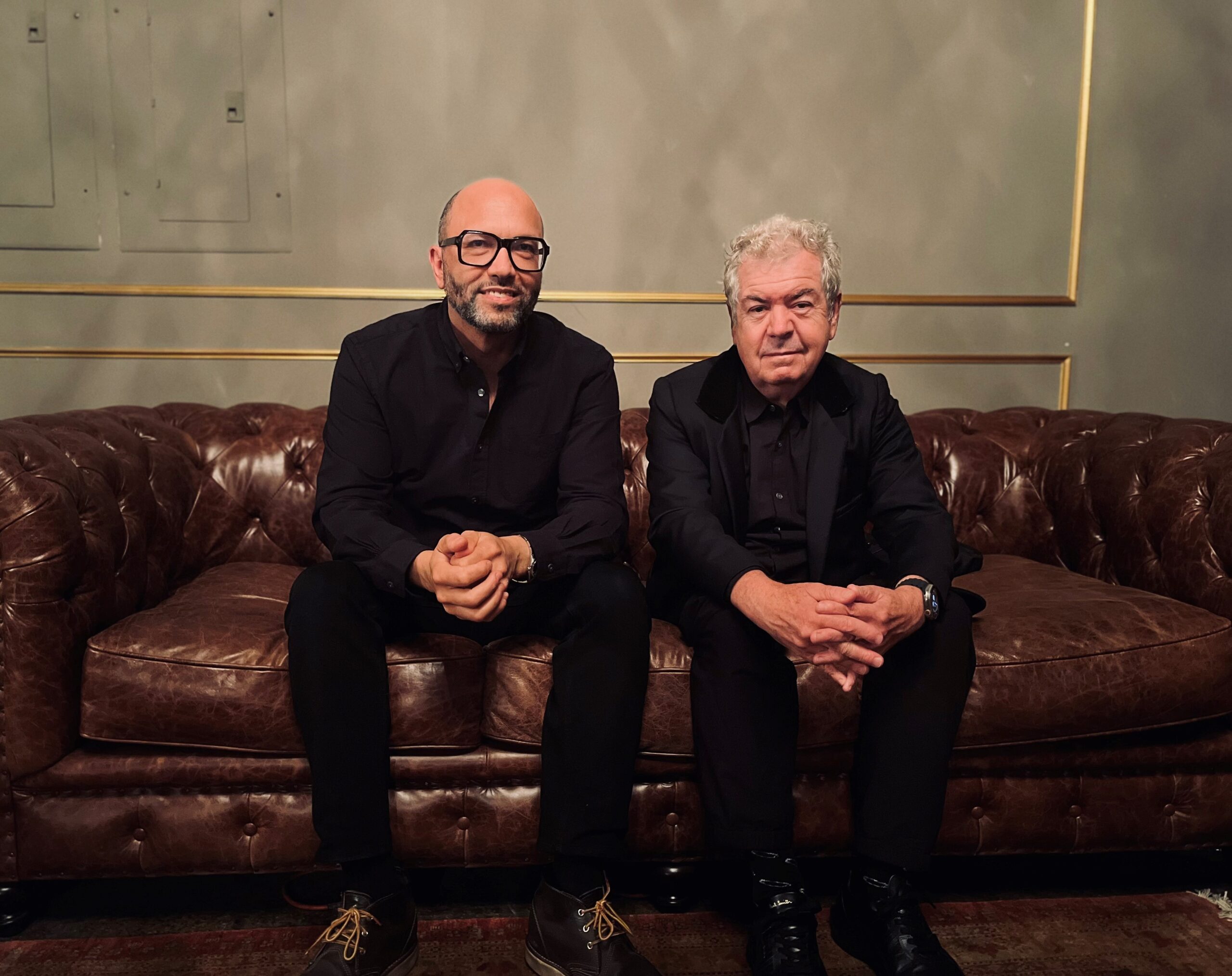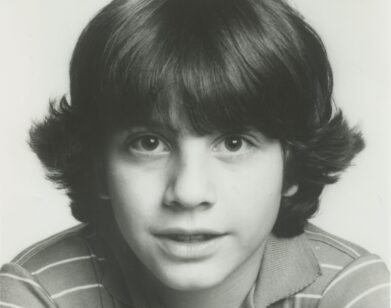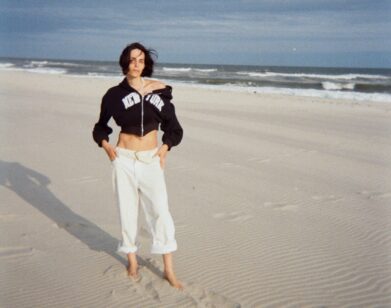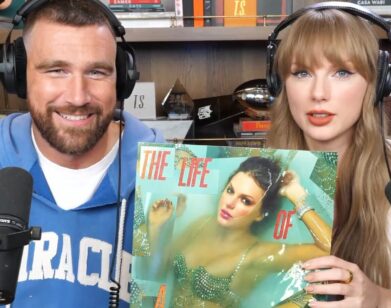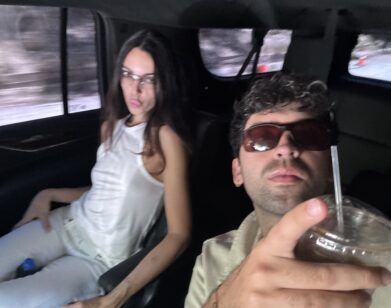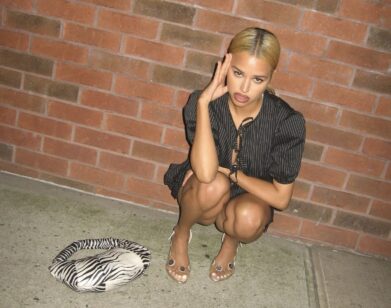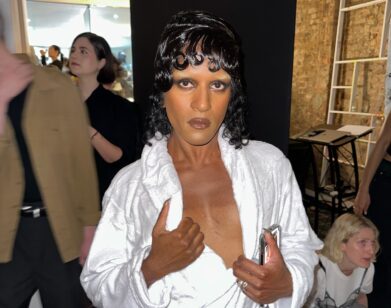NOSTALGIA
The Cure’s Lol Tolhurst on Madonna, Manchester, and His New Memoir, Goth
The Cure’s very first performance was at their Catholic School end-of-year assembly. Covering Alice Cooper’s “School’s Out,” Lol Tolhurst, the band’s drummer and co-founder, wore a black studded catsuit and eyeliner. He retells this tale about hoodwinking headmistress Sister Kathleen Bull as a sort of origin story of the band’s angsty and rebellious sensibility. And Tolhurst’s new memoir, Goth: A History, published last month by Hachette, dissects the influences of everyone from Sylvia Plath to Joy Division on the band, plus the web of luminaries and artists with whom he crossed paths along the way.
Last week, at Powerhouse Arena in Brooklyn, Tolhurst, whose new album Los Angeles drops next month, joined fellow musician and writer Nabil Ayers to talk about why he decided to write another book (his first, Cured, came out in 2016) and reminisce on Manchester, Madonna, and a fateful jam session with Tommy Lee. Their conversation, edited for clarity and brevity, appears below.
———
NABIL AYERS: We first met a little over a year ago in Palm Springs, maybe the least goth place in the world, when you were at my book talk and our good friend Joe Wong introduced us. I’m a drummer, you’re a drummer, Joe is a drummer. And you gave me a copy of Cured inscribed, “All drummers and authors are friends,” which is a very nice thing.
LOL TOLHURST: Yeah, it is true. All drummers are friends. There’s a truth in that. It’s like the Freemasons.
AYERS: And here we are a year later at your book event. I’m really happy to be here. Congratulations.
TOLHURST: Thank you.
AYERS: We talked about this a bit when I saw you recently in Los Angeles, but there’s a saying in music: “You have your entire life to write your first record, and six months to write your second.”
TOLHURST: Yeah.
AYERS: So your memoir, Cured, came out seven years ago, and writing a book is a much more solitary, painstaking process than an album. After already having written your memoir, how did you arrive at the concept for a second memoir?
TOLHURST: It was kind of difficult. Because the hardest thing is to figure out what your voice is going to be, how you’re going to tell the story. The story was always there, but I couldn’t figure out a way to get that across in the beginning. It’s not a history of Goth, because it doesn’t include every single little thing. I’m not a journalist, and that’s not how I wanted to do it, nor how I am capable of doing it. Also, doing something like that requires a lot of research, and I hate research. So I had to find a way to do it, and I only found out after about six months of thinking about it. I’d started reading a Californian writer, Joan Didion, and I love the way she wrote about the sixties and the seventies, and how she took stories that were factual stories, like news stories, and turned them into something like a noir novel. So I thought, “Okay, there’s a pattern for me to be able to work stories about other people into my own story.” With Goth, I thought, “Okay, it’s going to be a historical memoir. It’s going to be something that has the history leading you up to this point, but it’s also going to be the extra stories that I had that will help illuminate it.” So it took me a while. It’s like your second record. Until you find out what it is you’re really going to do, nothing happens.
AYERS: Right. A lot of what I found fascinating about this book, and what you write about so beautifully, is your lucky place in that history. You’re in the right place at the right time many times in your life. You’re not from London, but from a much smaller town, and you show up in Manchester for the first time in 1979? I’d love for you to talk about that.
TOLHURST: It was the discovery of a new world, but also a kinship, because we knew why we sounded like we did. Recently, in the last few years, with Google Earth and other things, I sort of traced it. I had a look around at the streets where we grew up and how we did things. It is absolutely no surprise to me why we sounded the way we did. It’s there in the dark, dank countryside. It’s there in those gloomy streets. In the ’70s, they built these huge projects stuck in the middle of Manchester. They took down all the old Victorian buildings and they built this thing that housed 30,000 people or something. And it was like, the worst form of brutalist architecture. It really wasn’t designed to house people. It was more a place to cage them, somehow. Of course, the inevitable happened. There was all kinds of calamity. So when we first arrived in Manchester to play, the original Factory club was right in front of this place. Seeing that, I understood how Joy Division sounded the way they did. And I think, sometimes, that’s forgotten, that music comes from the places as well as the people. It comes from the environment you grow up in. And that was very obvious to me with Manchester.
AYERS: Do you feel like being a drummer, at least primarily, gave you a sense of creativity in your writing? Meaning, because you weren’t trying to be a writer the same way you were trying to be a musician, did that allow you to do something different?
TOLHURST: Yeah, yeah. I think one thing that being in The Cure taught me overall was to always exceed your own expectations, because nobody else is going to. Nobody else is going to assume that you have other things in you. I’d always wanted to write. So the fact that I had written stuff for The Cure, which I explained in the book, helped me. The fact that we didn’t grow up in the center of the modern music world at the time was a good thing, because we were allowed to just grow at our own pace. There was only one other band in Crawley growing up, and it was a band fronted by Neil Gaiman, the author. Thankfully, he decided to give up. I read an article where he said, “The only other band in our town was The Cure, so we stopped.”
AYERS: Quite a compliment.
TOLHURST: Yeah, exactly. And he’s gone on to do really great stuff, so you’ll find your way.
AYERS: I’m curious to know more about your relationship with Budgie, who you met a long time ago, in 1979, and now have a podcast with and make music with.
TOLHURST: Like I say, all drummers are friends, right? And it’s like being in the Freemasons, you have the funniest handshake and stuff. Me and Budgie met each other in ’79. Every time The Banshees would come into town, I would always go and hang out and see. And it wasn’t until later on that Joe [Welmer] actually said to me, “I’m doing an interview with Budgie, he’s coming through, he’s playing with John Grant.” I said, “Okay, I’d love to go and see him.” And I went for lunch somewhere downtown and Budgie was there, and also Kevin Haskins, another drummer from Bauhaus, right? So we’re all chatting and the first thing I said was, “We’ve got to do something. Not like The Three Tenors, it’d be The Three Drummers.” And they’re like, “Okay, good.” So Budgie finished his tour with John Grant and then I persuaded him. Budgie came over, and me, him and Kevin got in my car, put as many things that would make noise as possible in the back, and drove up to Morrow Bay, which is in central California, and sat there and made noise at my friend’s house. We annoyed the neighbors for a week or so.. So I called up my good friend Tommy Lee, from Motley Crue.
AYERS: Sorry, “my good friend, Tommy Lee”?
TOLHURST: Yeah, right. The reason me and Tommy are good friends is not only that we’re drummers, but back in the mid-’80s, the Crue and The Cure and Madonna toured the same circuit in North America. We would never see Madonna, because she would just run into the hotel but Tommy was always in the bar, so we became pals.Anyway, we had this stuff that me, Budgie and Kevin had made, and I called Tommy up and I said, “Tommy, I know you have the best studio in town in your house. Can we borrow it for a couple of weeks? We want to record some stuff.” He said, “Yeah, I’ll give you the bro rate, but I’ll tell you what, don’t bring any drums because I have a shitload of drums.”Those were his exact words. And I went to his house and he has a room about the size of a bookstore, just full of drums. That excited Budgie a lot, because he got to sit behind Tommy’s kid and play. We made some tracks, and we asked Danny Lohner of Nine Inch Nails to help us produce it. After a couple of weeks, with other staff, we got an album, but it kind of sounded like what you expect an album made by a guy from The Cure, a guy from The Banshees, a guy from Bauhaus, produced by one of The Nine Inch Nails to sound like, and Then.Kevin got called back to go on tour with Bauhaus, and me and Budgie thought “What do we do?” But I knew Jacknife Lee socially, who’s not a drummer but loves drums, so I went to this old hippie festival on the top of Topanga Canyon because I knew he was going to be there, and John Densmore from The Doors was also there, introducing Willie Nelson’s sons band, who, I’m not a big country guy, as you might guess, right? But they were awesome. It was like punk country.So me and Jacknife sit there, just chatting about this, and then I say, “Well, I’ve got an album, can I bring it to you and see what you think?” And he said sure and we spent three or four hours listening to it, and he goes, “Okay, just like an Orange Juice song.Let’s rip it up and start again,” which is what we did. I walked out, probably crying, and called Budgie and told him I found our guy, that he had to get on a plane and that we’re making another album. Jacknife’sstudio is an Aladdin’s cave of every synth ever known to man on one side, and every drum and percussion thing. He doesn’t have any other instruments, so it’s perfect. We would go there every day, and we’d just jam, make music, and then we’d go home. The next day we’d go back up, and Jacknife would go, “Have a listen,” and he’d cut things together, so that’s how we started to make that record. Me and Budgie have such a strong connection, not just because of drums, even though I think he’s the best drummer of my generation, but our lives have so many parallels. I talked to him today, actually, I talk to him most days. We made that record, and then the pandemic hit. Originally, we thought it would be a classical album, but at that point we decided we had to do something with it, so we started sending out tracks to people. I knew James Murphy [of LCD Soundsystem], so I sent him some stuff, and he said, yeah, he’d love to. Budgie knows Bobby Gillespie, and we just started to pull other people in. Jacknife was working with Lonnie Holley, and he said he’d love to do some stuff. I love Lonnie, he makes up words. He has words that are composed of three other words into one word. He’s brilliant. So he’d got all kinds of people in there. We got Arrow from Starcrawler. That’s really what we did, while the pandemic went on. Sometimes people would come to the studio, sometimes people would just send us stuff. There’s that sort of music truism, you spend years with everything just ticking along, and then, all of a sudden, everything has to happen at once.
AYERS: What an absolutely amazing LA story. So glad I asked about Budgie. We got to Tommy Lee, he didn’t rap on the record, ever. That was never an option.
TOLHURST: I think that Tommy actually wanted to play on it, right?
AYERS: Sure, of course.
TOLHURST: His house is above the studio, so he couldn’t help but hear us. He would come down every afternoon, and sort of sit there a bit wistfully, waiting for us to go, “Come on, Tommy, go ahead and play.” I couldn’t persuade the others. I wanted to.
AYERS: Yeah. Some of my favorite parts of the book, there’s a lot of childhood stuff where you’re getting into music, and listening to records, at a time when music was not nearly as accessible as it is now. There’s a story that really warmed my heart about Alice Cooper. I’d love for you to tell it.
TOLHURST: Well, Robert and Micheal Dempsey and I went to a sort of radical school, it was Catholic, so how radical was it, really, but they tried to give us opportunities to do things. So at lunchtime we’d go to the music room, Robert would pluck his, I don’t know what the equivalent is here, but it’s like a Woolworth’s guitar for $20.
AYERS: Right, right.
TOLHURST: We’d plug that into the stereo system, and I’d loop to whatever drums were in the back, and we’d start making music. In our first year we had an American teacher, and he was quite open to stuff. He asked us if we’d like to play at the end of year assembly. We thought about it. We also thought about how we can disrupt the status quo a bit, because this is the start of ostensible punk leanings, and I had become heavily invested in Alice Cooper. I would see him in the music papers, and the first time the Cure ever played, we weren’t The Cure yet. So I approached our teacher and said, “Mr. Jones, there’s a song by an American singer, Alice Cooper. Do you think we could play it?” And he said to me, “Oh, I don’t think I know her.” I thought, “Perfect, he has no idea who I’m talking about, so he won’t get it, right?” So I said, “Yeah, yeah, she’s pretty good. And she’s made a song about school being out. That’s what you say, isn’t it, in America, when school’s finished for the year, and this is what’s happening now, so it’d be really appropriate.” And he went, “Yeah, yeah, yeah,” pretending that he knew what I was talking about. I persuaded my mother to get me this black studded catsuit and I persuaded Robert’s girlfriend, now his wife, to make my eyes, look like Alice. I’m glad there are no photos of this, because it would be everywhere on the internet. For the end of term assembly, the headmistress, she was a nun, Sister Kathleen Bull, said over the PA, “Oh, it seems like the students of all our classes were named after constellations, like Gruce, and Indus and Rivers, and things,” which were very ’70s, right? “But they’ve got some music to play by an American singer-songwriter Alice Cooper, so here’s her song.” And I started to play “School’s Out”. At first, all the staff are pretending to get into it, like, “Oh yeah, young people’s music, great.” Then they heard Neil’s drums come smashing in, and then, that big riff, and Alice is singing about how they’re never coming back to school, and all that stuff. And I think they were very glad I was leaving that year. Anyway, it was the first sort of proto-punk thing. That’s why I included Alice Cooper in the book.
AYERS: And there was a small detail, too, that I love. I think you said you went to the next town to buy the record, because …
TOLHURST: Oh, yeah, If I bought it in our town, somebody would have noticed, like, “What are they doing? What are they up to?”
AYERS: So that’s how small the town was.
TOLHURST: Yeah, right.
AYERS: Thank you, and congratulations.
TOLHURST: Yes, thank you. Thank you.

